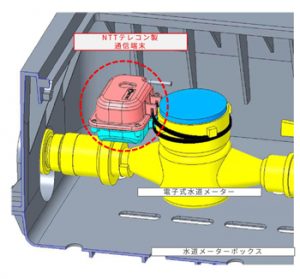Remote meter reading with water DX Amami Islands municipalities, NTT West Kagoshima, and NTT Telecon Kyushu

The Amami Islands municipalities, NTT West Kagoshima and NTT Telecon Kyushu have signed an agreement to conduct a “water smart meter demonstration experiment” to promote digital transformation of water supply-related operations. The demonstration experiment will involve multiple municipalities in a specific area (nine municipalities in the Amami Islands) jointly verifying remote water meter reading using communication terminals and a centralized monitoring system. The experiment will begin in August of this year and run until May of next year.
Miyata Ken, manager of social infrastructure sales at NTT West’s Kagoshima, said, “We are working on solutions related to social infrastructure and are rolling out a variety of solutions to local governments in Kagoshima Prefecture. Kagoshima has many remote islands, and these local governments face challenges in maintaining their infrastructure. We are considering how we can support them. NTT Telecon proposed using smart water meters to improve the efficiency of water infrastructure, and we began working on this initiative. We contacted local governments in the Amami Islands and concluded an agreement to begin with a trial.”
Specifically, communication terminals and electronic water meters will be connected to nine local governments in the Amami Islands, and remote meter readings will be carried out via NTT Telecon’s centralized monitoring center.

水道スマートメータ―の設置イメージ(Smart water meter)
Nakajima Nobuki, manager of NTT Telecon’s Kyushu, explains, “The data obtained by the smart water meters is stored in our centralized monitoring center in Saitama Prefecture, and staff in the nine local governments can access the data as a cloud service.”
If an alert is raised about a water leak or a tap being left open, the staff member will be notified via email.
Smart water meters have been installed in a total of 58 locations across nine municipalities. They are mainly installed in single-family homes, but also in apartment complexes, public facilities, and Self-Defense Force bases.
Remote meter reading eliminates the need to dispatch meter readers to the sites. The naturally rich Amami Islands have some difficult-to-access areas, which has placed a burden on meter readers, but this burden will be alleviated.
Nakajima says, “We often hear from municipalities that due to the aging of meter readers and labor shortages, it will become difficult to secure meter readers in the future. Remote meter reading will also have a major benefit in terms of providing sustainable and stable water services.”
This is the second smart water meter initiative in the Kyushu region and the first in Kagoshima Prefecture.
The first example is Kijyo Town in Miyazaki Prefecture, where a similar demonstration experiment has been underway since February of this year.
Yoshihiro Hashimoto, sales manager at NTT Telecom’s Kyushu, said, “Smart water meters can collect data 24 hours a day, in hourly increments, so we can infer the condition of each household. For this reason, Kijyo town is considering applying it to a monitoring service.”
Masayuki Nishino, in charge of social infrastructure sales at NTT West’s Kagoshima, added, “For example, leaks can occur from the water purification plant to the lower section. If we install smart water meters at the water purification plant and lower down, we will be able to detect this section, so we would like to encourage such applications, particularly with local governments in the Amami Islands.”
Nakajima said, “First, we would like to promote the effects of smart water meters to local governments through demonstration experiments, and then work with NTT West to advance proposals.”
※Translating Japanese articles into English with AI
